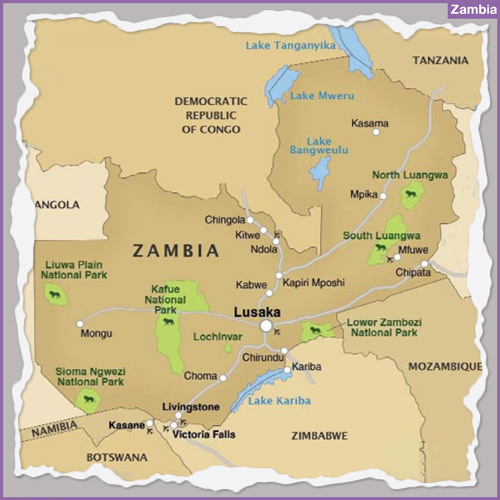ZAMBIA, SOUTHERN AFRICA

Zambia,with many monuments and historic sites to visitis blessed with awe-inspiring natural wonders, an abundance of wildlife, huge water bodies and vast open spaces that offers unforgettable holidays exploring the real Africa. Home to three great natural lakes, Lake Tanganyikais the longest, and second deepest lake in the world, Lake Kariba is Africa’s largest man made dam and rapidly becoming Zambia’s own French Riviera, and the tropical and wild Lake Mweruin the far north, offers a fascinating glimpse of village life that lines the shores of this vast lake . The land of the legendary African walking safari, Victoria Falls and the wild Zambezi River, a vibrant mix of cultures and traditionsits widely-considered to be one of the friendliest, welcoming nations in the world.
Topography & Climate
Zambia is a landlocked country, its Zambezi River flows over the famous Victoria Falls before emptying into the Indian Ocean. The land, mostly of a high plateau where hills and mountains are dissected by river valleys. There are three main seasons: cool and dry from May to August when temperatures are typically 25 to 30 OC – hot and dry from September to November when it ranges between 28 and 35 OC – warm and wet from December to April when temperatures fall back to 25 to 30 OC. Only in the Valleys of the Zambezi and Luangwa is there excessive heat, particularly in October and, in the wet season, a high humidity.
Holidays and tours featured at this destination
General Information
Luxury accommodations we currently recommend are:
The River Club | Royal Livingstone Hotel | AVANI Victoria Falls Resort | Chrismar Livingstone | Tongabezi Lodge | Sindabezi Island
Livingstone, is a town in southwestern Zambia, a few kilometres from the Zambezi River and the border with Zimbabwe. Named after the famous explorer, Dr. David Livingstone, Livingstone Town was established in 1905. Being close to the Zambezi River crossing to Southern Rhodesia the town became a major European settlement, and was made the capital of Northern Rhodesia in 1911. As the capital, it enjoyed excellent facilities far superior to anything elsewhere in the country, as can be seen from the surviving Edwardian buildings that line the city’s main road. It even had the country’s first newspaper but when the capital was moved to Lusaka in 1935 the bustling city became a quiet town. Nowa hub for visitors to the Victoria Falls and the Mosi-oa-Tunya National Park which surrounds the Zambian side of the Fallsit still retains a special charm. The Livingstone Museum traces local history and archaeology, and the life of David Livingstone, during 2011 a major event occurred – the installation of the town’s first set of traffic lights!Its proximity to the Zambezi River and the spectacular Victoria Falls continues to attract visitors from all over the world, who are accommodated in several luxury hotels and stunning lodges within the immediate vicinity.
Sindabezi Island, is unique – the discerning traveller’s best kept secret. An idyllic, exclusive camp on a private island situated in the middle of the Zambezi River around 18 kilometers upstream from the mighty Victoria Falls. Sindabezi Island only sleeps 10 guests on the entire island; these are accommodated in five open-sided thatched cottages. Each of the cottages has open fronts facing onto the river allowing you to encounter the African Bush sights and sounds. These cottages have every amenity you could wish for including a sundeck, outside heated shower, canopied bed and ‘loo with a view’, and is the only luxury bush camp from where Victoria Falls can comfortably be explored. With amazing views across the flood plains of the Zambezi and into the nearby National Park it’s a thousand light years away from the bustle at night. Fodor’s voted Sindabezi one of the top 10 eco lodges in Africa, the unique Cottage design allow guests to encounter up close all the sights and sounds of the river and the creatures that live in and around it, that includes regular visits from Horace, the resident hippo. At night, you will fall asleep in the glow of a hurricane lamp and be awoken by magnificent sunrises over the flood plains of the river. The main camp area is set on the sand is the perfect place to relax, unwind and enjoy the peace and tranquility of this tiny island, with staff always on hand to guarantee your every comfort. At night, the main camp is transformed into a world of yesteryear, with the absence of electricity adding to the romance and charm of this magical island. Five -star dining on the sand, under the canopy of stars, with the river meandering past and the unmistakable sounds of hippos wallowing nearby, assure an experience never to be forgotten. Activities around the island include motorboat and canoe safaris, fishing,sanpan floating candlelit dinner, a visit to the Mukuni Park, an introduction to Simonga Village, guided bush walks, a visit to Victoria Falls, game drives, and a Maramba market visit. Sindabezi Island is ideal for a Honeymoon safari, for families or a small party looking for complete privacy. Taking the island privately ensures a private guide, a vehicle, and a boat that can be used as a scenic transfer to Tongabezi lodge, where use of the services and facilities come as part of the package.
The Victoria Falls, is one of Africa’s, if not the world’s great attractions. Located in southern Africa on the Zambezi River at the border of Zambia and Zimbabwe it was described by CNN as one of the Seven Natural Wonders of the World.Discovered in 1855 by the famous explorer David Livingstonewho wasthe first European to cross Africa from south to north he named it after Queen Victoria. Being struck by its beauty, in 1857 Livingstone wrote “no one in England can even imagine the beauty of this scene, its most probably angels are admiring the scenery while flying nearby”. For centuries local African tribes had a sacral fear of the waterfall which can be heard from a distance of 40 kilometers, its spray and mist from the falling water rises to a height of over 400 meters and can be seen from a distance of 50 kilometers. So it’s understandable that the local tribes used to call the waterfall Mosi-o-Tunya “The Smoke that Thunders”. A UNESCO World Heritage Site, it is neither the highest nor the widest waterfall in the world but is classified as the largest, based on its combined width of 1,708 metres and height of 108 metres resulting in the world’s largest sheet of falling water.
The Victoria Falls is effectively made up of five different “falls”. The Eastern Cataract on the Zambian side and the Devil’s Cataract, Main Falls, Rainbow Falls and Horseshoe Falls are on the Zimbabwean side.The Eastern Cataract “falls”are entirely on the Zambian side of Victoria Falls, 101 metres deep, they are the second deepest. The Devil’s Cataract “falls” are about 70 metres deep and derive the name from an adjacent island in the Zambezi River where it’s said natives used to conduct sacrificial ceremonies, considered a “devilish” practice by the missionariesit resulted in the name of the area. The Main Falls with a wide curtain of water thundering into the gorge below is the most majestic section which throws out a magnificent spray that constantly nourishes the areas evergreen forest.The Horseshoe Falls are horseshoe shaped and 95 metres deep, this section usually dries up at the height of the dry season between October and November. The Rainbow Fallsfrom where a beautiful rainbow can been seen is 108 metres deep, the deepest of the whole series of “falls”.
Livingstone Island, is a real island in the Zambezi River located right on the edge of the top of the Victoria Falls, just before the water falls down a 101-metre drop. Historically it’sthe place that explorer Dr. David Livingstoneis said to have first viewed the Falls, in November 2005 a plaque unveiled to mark the spot from where Livingstone was the first European to see the Falls.Access to this unique island is limited to just 80 visitors per day and to protect the sensitive environment, only 16 guests may visit at any one time. Access is also seasonal, generally between end of August thru Decemberand that dependsentirely on the water level of the Zambezi River. Visitors may swim in Devils Pool a small lagoonenclosed by rocks on the lip of the Falls if accompanied by a guide. The Angles Armchairisanother smaller rock pool even closer to the edge. All Livingstone Island visits should be accompanied by a professional guide.
Mosi-oa-Tunya National Park,”The Smoke Which Thunders”, is an UNESCO World Heritage site[2] that is home to one half of the Victoria Falls on the Zambezi River, and ‘twin’ to the Victoria Falls National Park on the Zimbabwean side. The Parkstretches around 20 kilometres up the Zambezi River from the Songwe Gorge below the Falls up to the Batoka Gorges. Its south-western boundary is shared with that of Livingstone town. The Mosi-oa-Tunya National Parkhas two sections each with separate entrances. At its north-western end is the Wildlife park of riverine forest, palm trees, miombo woodland and grassland, home to a vast number of birds, and animals. Being a small Park it affords a wonderfully relaxing drive alongside the river for much of the circular route, and the wide variety of species can be seeninclude Angolan giraffe, Grant’s zebra, warthog, sable, eland, Cape buffalo, impala, white rhino and the indigenous black rhino, believed extinct in Zambia, it was reintroduced in a pilot area. In 2009 a commercial wildlife company, Lion Encounter, started operating a “walking with Lions” experience within the park, with further plans to start a breeding programme for Southwest African lions. This activity could have been suspended and anyone interested needs to check directly with Lion Encounter through their website.Also in this Wildlife section is the Old Drift cemetery where the first European settlers were buried. The Fallssection of the national park includes the rainforest on the cliff opposite the Eastern Cataract, which is sustained by the Fallsspray. This section also contains plants rare for the area such as pod mahogany, ebony, ivory palm, wild date palm and a number of creepers and lianas – and, a statue of explorer David Livingstone which was erected in November 2005. Small antelopes and warthogs inhabit this area, and may also be seen on the paths through the riverine forest leading to the Falls.
Lower Zambezi National Park, located in south-eastern Zambia is where a wilderness still exists, a place that doesn’t feel overtaken by humans that provides an unpredictable safari experience. Landlocked between the Tropic of Capricorn and the Equator, shaped like a butterfly and covering about 752,610 square kilometres, it was declared a national park in 1983, having previously been a private park of the Zambia president. UNESCO subsequently declared several areas of the Lower Zambezi as World Heritage sites, principally because it is home to a ‘remarkable concentration of wildlife’. There are herds of elephants and buffaloes, an impressive population of Nile crocodiles and predators such as lions, leopards and the African wild dog. What makes this park a great destination for a safari is the concentration of wildlife around the water, this offers terrific photo-opportunities as enormous herds of elephants, some up to a hundred strong, gather at the Zambezi River’s edge. The Lower Zambezi National Park and Zimbabwe’s famous Mana Pools National Park on the opposite river bank make the entire area is a true wildlife sanctuary. Because there are no fences between the two “parks” animals can roam free across the area and will frequently do so. The best part of the Lower Zambezi Park and its surrounding area is the remoteness. Unlike other South African parks, this one has no paved roads, so it is quite likely you will encounter another safari vehicle.
South Luangwa National Park, is located in eastern Zambia is also the southernmost national park of the three situated in the Luangwa River valley. It is one of the best-known national parks for walking safaris in Africa. Founded as a game reserve in 1938, it became a national park in 1972. Experts have dubbed South Luangwa to be one of the greatest wildlife sanctuaries in the world, and not without reason. The concentration of animals around the Luangwa River, the most intact major river system in Africa, and its oxbow lagoons is among the most intense in Africa; inside the Mfuwe Gate entrance, the river is often crowded with hippos. The changing seasons add to the Park’s richness, ranging from; dry, bare bushveld in the winter, to a lush, green wonderland in the summer months. There are around 60 different animal species and over 400 different bird species in the South Luangwa National Park, with the notable exception of the rhino which we understand was sadlypoached to extinction. This world-renowned wildlife haven supports two endemic species, the Thornicroft Giraffe and Cookson’s Wildebeest, herds of elephants and Cape buffaloes, often several hundred strong,and is one of the best parks in Africa to view leopards in their natural environment. Game concentrations are at their height during the dry season which begins in April and intensifies through to October, the hottest month.
The Royal Livingstone Express Train,is made up of five fully air-conditioned carriages, beautifully restored by Rohan Vos of Rovos Rail and pulled by either a 156 locomotive or a 204 Locomotive. Configured from the front as follows: The Steam Locomotive, 10th Class “Prince of Mulobezi”, built by North British Locomotive Company in England between 1922-4. The Royal Livingstone Express Train Club Car Carriage No. 6049,this car consists of a small lounge and bar and as the kitchen;it can also be used as a pre-dinner drinks venue for about 10 guests. The Royal Livingstone Express Train Dining Car Carriage No. 4821, this Chesterfield Leather car has been beautifully restored. The Royal Livingstone Express Train Dining Car Carriage No. 211, sister to famous Wembley dining car,built in 1923, was named where it was exhibited for the 1924 British Empire Exhibition.The Royal Livingstone Express Train Lounge Car Carriage No. 4101,has been beautifully restored. The Royal Livingstone Express Train Observation Car Carriage No. 493,sits at the back of the train and houses a bar and veranda viewing deck.
The Royal Livingstone Express Steam Train Dinner, the Royal Livingstone Express Train takes you back to a bygone era, you experience colonial splendor when you embark on a four hour journey in the comfort of stately carriages to the Victoria Falls Bridge.Guests join the The Royal Livingstone Express Train at Bushtracks Siding, formerly the Old Mulobezi Railway Offices or otherwise known as Kilometre ‘0’ of the Mulobezi Line. Tthe Steam Train is boarded through the Lounge Car where drinks and snacks will be served before it departs at 17:00 Hrs.The steam train leaves Livingstone on the “Cape to Cairo” mainline and travels into the Victoria Falls World Heritage Site up to the Zimbabwe border and crossing onto Victoria Falls Bridge. Once on the Victoria Falls Bridge you will be invited to step off the train and onto the bridge to watch the sun set behind the Victoria Falls. The Steam Train then starts its journey back to Livingstone, stopping at the Palm Grove siding where a gourmet dinner is served before returning to Bushtracks Siding. The Royal Livingstone Express Steam Train Dinner offers the discerning guest the ultimate dinner experience, invoking the glorious age of steam and a view of the world-famous Victoria Falls at sunset.








